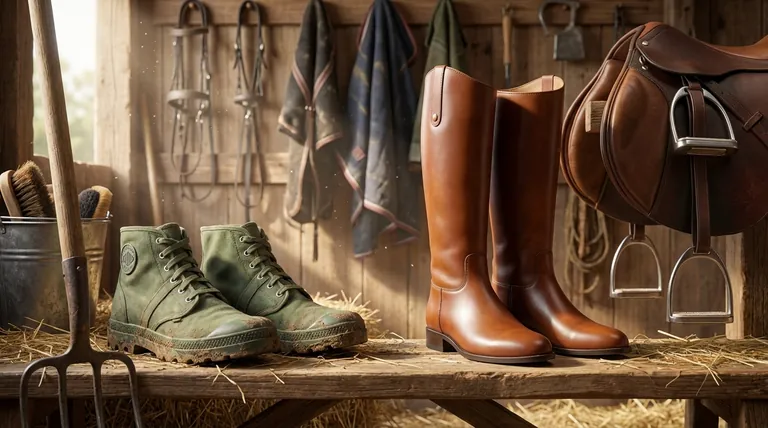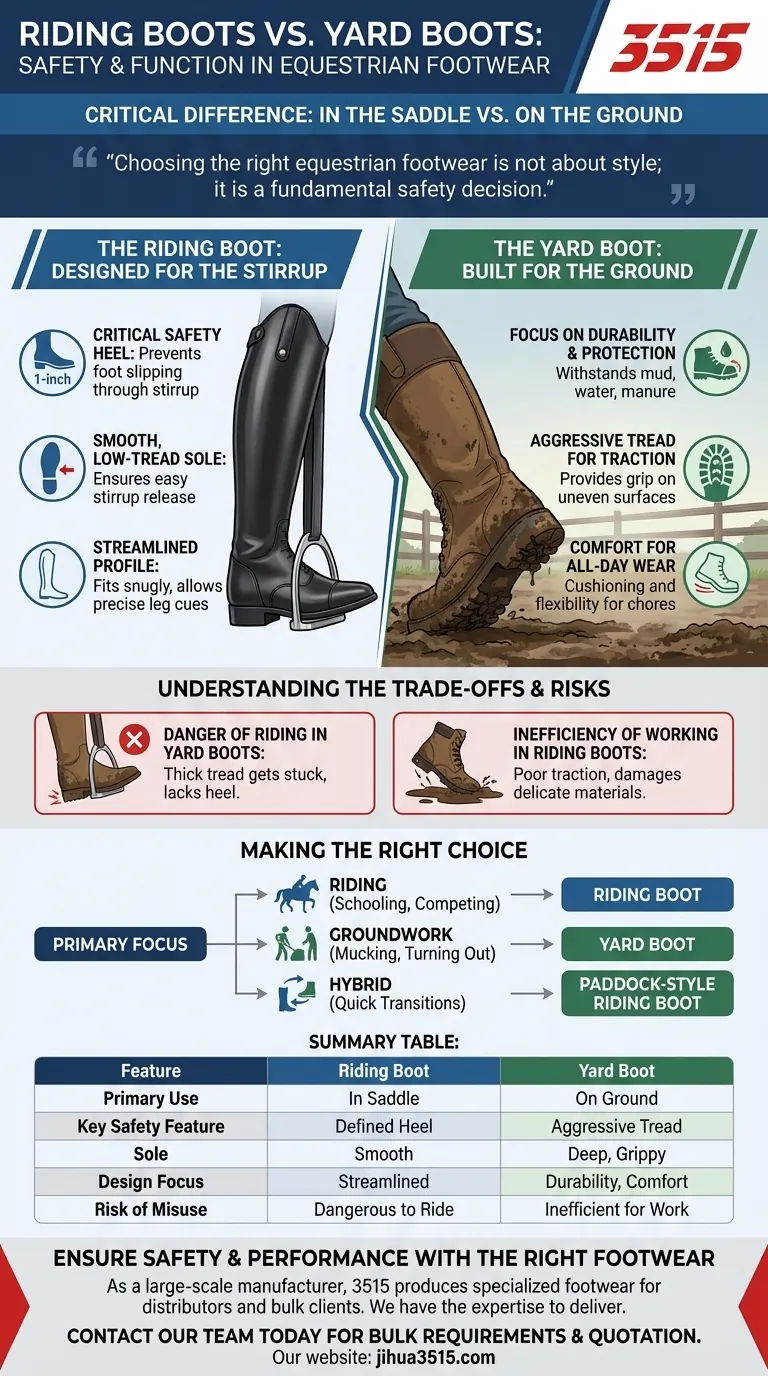In short, the critical difference is safety and function in the saddle. Riding boots are specifically engineered for use with stirrups, featuring a distinct heel to prevent the foot from slipping through and a streamlined, smooth-soled fit. Yard boots, by contrast, are general-purpose work boots designed for groundwork, prioritizing durability, traction, and all-day comfort for chores around the barn.
Choosing the right equestrian footwear is not about style; it is a fundamental safety decision. A riding boot is a specialized tool for performance and safety in the saddle, while a yard boot is a protective tool for work on the ground. Using one for the other's job is inefficient at best and dangerous at worst.

The Riding Boot: Designed for the Stirrup
A riding boot’s design is entirely dictated by its interaction with the saddle and stirrup. Every feature serves to enhance rider safety, communication, and effectiveness while on the horse.
The Critical Safety Heel
The most important feature of a riding boot is its defined heel, typically around one inch high. This heel acts as a crucial stopper, preventing the rider's foot from sliding completely through the stirrup, which is a primary cause of serious dragging accidents.
A Smooth, Low-Tread Sole
Riding boot soles are intentionally smooth or have very light treading. This ensures the foot can easily slide out of the stirrup in an emergency. A thick, grippy tread, common on other boots, can become dangerously wedged.
A Streamlined Profile
Riding boots, whether tall or short paddock-style, have a slim profile that fits snugly against the ankle and calf. This prevents the boot from catching on the saddle and allows for the subtle leg cues a rider uses to communicate with the horse.
The Yard Boot: Built for the Ground
A yard boot is fundamentally a work boot adapted for the unique conditions of a stable or farm. Its purpose is to provide protection, stability, and comfort for hours spent on your feet.
A Focus on Durability and Protection
Yard boots are built to withstand mud, water, manure, and the occasional misplaced hoof. They often feature waterproof materials, robust construction, and sometimes a reinforced or steel toe for added protection.
Aggressive Tread for Traction
Unlike a riding boot, a yard boot requires an aggressive, deep tread on its sole. This provides essential grip and stability when walking on uneven, wet, or muddy surfaces, preventing slips and falls.
Comfort for All-Day Wear
These boots are designed for walking, lifting, and crouching. They typically have more cushioning, a wider toe box for comfort, and greater flexibility than a stiff riding boot.
Understanding the Trade-offs: Why You Can't "Just Use One"
While it may seem practical to own a single pair of do-it-all boots, the specialized designs create significant safety and performance trade-offs.
The Danger of Riding in Yard Boots
This is the most critical point to understand. The thick, grippy tread of a yard boot can easily get stuck in a stirrup, posing a significant safety risk. Furthermore, many lack the well-defined heel needed to prevent the foot from slipping through.
The Inefficiency of Working in Riding Boots
Using expensive riding boots for barn chores is impractical. Their smooth soles offer poor traction in mud, and the often delicate leather is not designed to stand up to the harsh, wet conditions of groundwork. They are also typically stiffer and less comfortable for long hours of walking.
Making the Right Choice for Your Task
Your choice of boot should always be dictated by the specific task at hand to ensure both your safety and the longevity of your equipment.
- If your primary focus is riding (schooling, hacking, competing): Always use a dedicated riding boot with a proper heel and a smooth sole for safety in the stirrup.
- If your primary focus is groundwork (mucking out, grooming, turning out): Choose a sturdy, comfortable yard boot with good traction and protective features.
- If you need a hybrid solution for quick transitions: Look for short, paddock-style riding boots, which offer the necessary safety features for riding but are more comfortable for light groundwork than tall boots.
Selecting the right boot is a foundational element of safe and responsible horsemanship.
Summary Table:
| Feature | Riding Boot | Yard Boot |
|---|---|---|
| Primary Use | In the saddle | On the ground (chores) |
| Key Safety Feature | Defined heel to prevent slipping through stirrup | Aggressive tread for ground traction |
| Sole | Smooth, low-tread for easy stirrup release | Deep, grippy tread for stability |
| Design Focus | Streamlined profile for communication & safety | Durability, protection, and all-day comfort |
| Risk of Misuse | Dangerous to ride in (can get stuck in stirrup) | Inefficient and damaging for riding |
Ensure Your Safety and Performance with the Right Equestrian Footwear
As a large-scale manufacturer, 3515 produces a comprehensive range of specialized footwear for distributors, brand owners, and bulk clients. Our production capabilities encompass all types of equestrian boots, ensuring you get the precise safety features and durability your customers need.
Let us help you equip riders correctly. Whether you need riding boots engineered for stirrup safety or durable yard boots for stable work, we have the expertise and capacity to deliver.
Contact our team today to discuss your specific requirements and receive a tailored quotation.
Visual Guide

Related Products
- Factory-Direct Wholesale Canvas Boots with High-Traction Rubber Soles
- Safety Footwear Wholesale Manufacturer for Custom OEM/ODM Production
- Wholesale High-Traction Camo Boots - Custom Manufacturer for Brands
- Premium Wholesale Waterproof Safety Boots High Performance Protection for Industrial Markets
- Customizable Anti-Smash Safety Boots for Wholesale & Private Label Manufacturing
People Also Ask
- What role do slip-resistant rubber materials play in safety shoes? Ensuring Grip and Stability in Hazardous Workplaces
- Why is rubber a popular material for shoe soles? Unbeatable Grip, Durability & Value
- What are the advantages of rubber soles in safety boots? Unbeatable Grip & Durability
- What is a vulcanized sole? Discover the Secret to Superior Flexibility and Grip
- What should be avoided when storing boots with outsoles? Protect Your Investment from Dry Rot & Decay



















